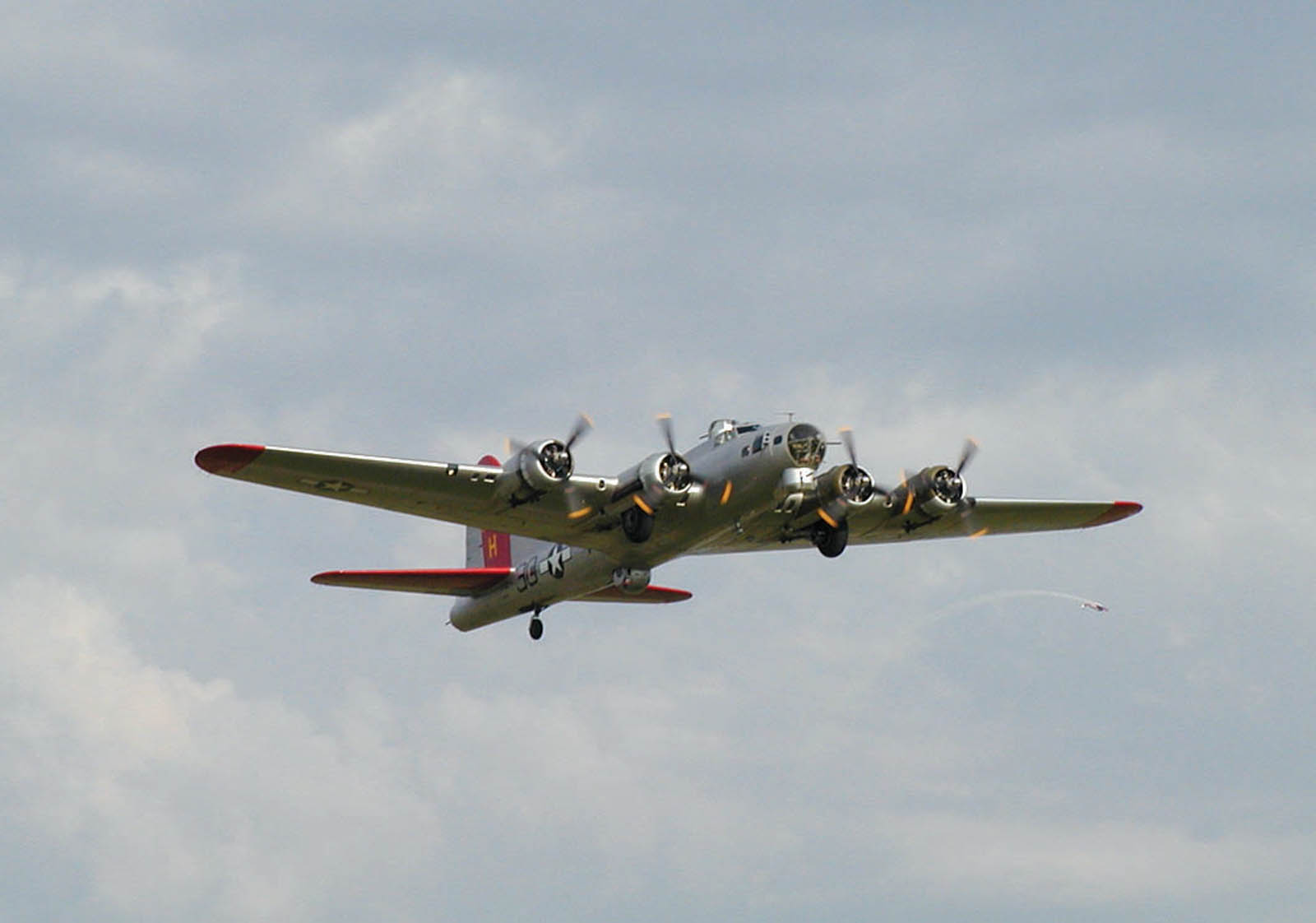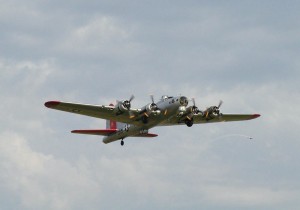
The B-17 Flying Fortress, considered the first truly mass-produced large aircraft, was used in the daylight precision strategic bombing campaign in Europe.
By Henry M. Holden
Sept. 18, 2007, marks the 60th anniversary of the United States Air Force. For the last six decades, the world has watched as the Air Force shielded America from potential threats and witnessed it launching deterrents more powerful than those flown in World War II. Many in the world are also the beneficiaries of its humanitarian and relief efforts.
Air Force history isn’t just about air power; it’s also about people who had the vision to see how air power could maintain peace.
Roots of the modern Air Force
The modern Air Force precedes its anniversary by 40 years, to the early days of powered flight. On Aug. 1, 1907, the U.S. Army Signal Corps formed an Aeronautical Division, just three and a half years after the Wright brothers flew the world’s first controlled powered flight at Kitty Hawk, N.C.
Under the leadership of such officers as Capt. Benjamin D. Foulois, Lts. William “Billy” Mitchell, Henry “Hap” Arnold, James “Jimmy” Doolittle and Thomas Selfridge, a small band of young Army airmen experimented with the early aircraft and shaped the future of the Air Force. On Sept. 17, 1908, Selfridge had the unwanted distinction of becoming the first American killed in an airplane crash while flying with Orville Wright. Wright escaped with serious injuries.
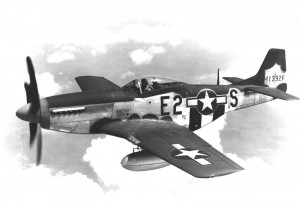
The P-51 Mustang, a long-range single-seat fighter aircraft, was the first fighter that could escort bombers deep into enemy territory. The P-51 became one of WWII’s most successful and recognizable aircraft.
Prompted by Congressional legislation, the Army established the Aviation Section of the Signal Corps in July 1914. Weeks later, most of Europe went to war. In April 1917, the United States entered World War I. By that time, the Germans and British had developed advanced aircraft, but the U.S. was unable to catch up in aviation technology. On May 24, 1918, President Woodrow Wilson created the Army Air Service and placed it under the War Department.
Gen. William Mitchell
In September 1918, Brig. Gen. William “Billy” Mitchell, commanding all American air combat units in France, planned and led one of the first coordinated air-ground offensives in history, in the Battle of Saint-Mihiel. By the time of the armistice six months later, the Air Service had grown to more than 19,000 officers and 178,000 enlisted men and American industry had produced 11,754 aircraft (mostly Curtiss JN-4D Jenny trainers). The military scrapped most of these aircraft or sold them to civilians in the rapid demobilization after the war.
While the U.S. had failed to deploy adequate combat aircraft during the war, it had sent many young aviators to Europe. Flying mostly French-built planes, they distinguished themselves first in the Lafayette Escadrille and then in allied units and as part of the American Expeditionary Forces. By the time of the armistice, Mitchell had brought most of the aero squadrons into an organized and formidable strike force.

The B-25 Mitchell bomber was the only airplane named after a person. Lt. Col. Jimmy Doolittle used this aircraft on his raid to Japan. His bombers took off from an aircraft carrier, bombed Japan and provided a needed psychological lift for America.
Before the war ended, the British recognized the importance of air power by creating the Royal Air Force, independent of the British Army and Royal Navy. Visionaries such as Mitchell, later called the “Father of the Air Force,” urged the U.S. to follow the British example, but he was met with bitter opposition. Mitchell enraged the Navy by claiming he could sink ships “under war conditions.” In an experiment in 1921, under static conditions, Mitchell’s airplanes successfully sank several ships, including the captured German battleship, Ostfriesland, and the U.S. battleship Alabama.
The Army Reorganization Act of 1920 made the Air Service a combat arm of the Army, and the Air Corps Act of July 2, 1926, changed the name to the Air Corps. While Germany and Japan began to build up their armed forces, the U.S. military remained a small, peacetime force with limited budgets for modernization. Mitchell didn’t share his peers’ common belief that WWI was the war to end all wars. His relationship with his superiors deteriorated as he criticized the War Department for their lack off vision.
To reduce the controversy, military officials sent Mitchell to Asia in 1924. He returned with a written report predicting a future war with Japan, including an attack on Pearl Harbor. “Winged Defense,” published in 1925, was largely ignored.
When the Navy dirigible Shenandoah crashed in a storm in 1925, killing 14 of the crew, Mitchell accused senior leaders in the Army and Navy of incompetence and “almost treasonable administration of the national defense.” President Calvin Coolidge ordered Mitchell court-martialed. He was found guilty of insubordination and suspended without pay from active duty for five years. Unwilling to suffer the humiliation, Mitchell resigned in February 1926. He spent the next decade advocating air power to the few people who would listen. He died of influenza in 1936.
Gen. Henry H. Arnold

The name of the Boeing B-29 Superfortress, a four-engine, heavy propeller-driven bomber, was derived from its well-known predecessor, the B-17 Flying Fortress. The B-29 delivered atomic munitions to Japan, ending World War II.
Gen. Henry Harley “Hap” Arnold oversaw the expansion of the Air Service during WWI and became a protégé of Mitchell. Arnold became a powerful advocate for creation of an independent Air Force and played a key role in the political struggles with the Army and Navy. This nearly ended his career.
When Hitler launched WWII by invading Poland in September 1939, the Army Air Corps had 26,000 personnel and fewer than 2,000 planes. By war’s end, with America’s industrial might and human resources, the Army Air Forces reached peak strength of 80,000 aircraft and 2.4 million personnel.
On June 20, 1941, the Department of War created the Army Air Forces as its aviation element and made it co-equal with the Army ground forces. The AAF expanded rapidly after the Japanese attack on Pearl Harbor, on Dec. 7, 1941. Early in 1942, AAF Lt. Col. Jimmy Doolittle led a raid on the Japanese homeland. His B-25 bombers took off from an aircraft carrier and bombed Japan, providing a needed psychological lift for America.
On March 9, 1942, the War Department granted the AAF full autonomy, equal to and separate from the Army ground forces, with Arnold becoming its commanding general.
Air power in WWII
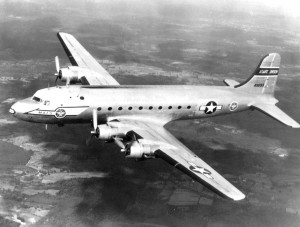
The military version of the Douglas DC-7, the C-121A, flew non-tactical missions in the 1950s, under the command of the Military Air Transport Service.
The Eighth Air Force became the primary strategic bombing force against Nazi Germany. Arnold named Gen. Carl Spaatz its commander, with Gen. Ira Eaker as the head of its bomber command. Fighting on several fronts forced Arnold to reallocate resources from the Eighth to support operations in North Africa. This crippled the Eighth Air Force and nearly wiped it out as an effective unit.
Eaker discovered that the pre-war doctrine of not using fighter escorts for heavily armed bombers penetrating enemy defenses was nearly suicidal. Early in 1943, Eaker requested more fighters, equipped with fuel tanks that could be jettisoned, increasing their range to cover the bombers. Opponents of Eaker’s strategic daylight bombing included his fighter commanders; they argued that the use of drop tanks endangered the fighter aircraft.
Heavy aircraft losses in the summer and fall of 1943 increased Eaker’s desperation. Arnold, impatient for results, ignored Eaker’s requests and placed the blame for the heavy losses on a lack of aggressive bomber commanders.
During that time, Gen. Dwight D. Eisenhower was building his command staff for the D-day invasion. Arnold agreed to Eisenhower’s request to replace Eaker with his own commanders, Spaatz and Doolittle. Ironically, the very materials Eaker requested—more bombers and P-51 fighters with drop tanks—accompanied the change of command and brought success to the Eighth Air Force’s missions.
Bombing results
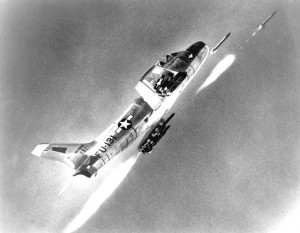
The F-86 Sabre jet was developed in the 1940s, following the end of World War II, and was one of the most-produced western jet fighters in the Cold War era. The F-86 Sabre established air superiority over the Russian-built MiG 15.
By early 1944, after thousands of bloody dogfights and the long pulverizing bombing missions over Europe, the skies were virtually cleared of the German Luftwaffe. This gave the Allies air superiority and led to the successful D-day landings, on June 6, 1944.
By early 1945, the Allied Air Forces had disabled Germany’s river and canal network. Its rail system was in ruins and with that went the country’s coal industry that powered Germany’s economy.
“Even a first class military power, rugged and resilient as Germany, cannot live long under the full scale and free exploitation of air weapons over the heart of its territory. For the first time in modern history, the economy of a world power had been destroyed by air power,” Concluded the U.S. Strategic Bombing Survey report.
The quantity and quality of AAF aircraft and airmen dominated the skies over both Germany and Japan and all but paralyzed their war economies. Air power in the Pacific had isolated the Japanese on the islands and destroyed its navy. Air power didn’t win the war but made it possible for the Allies to gain and hold the battleground, and win total victory.
Dawn of the atomic age

In 1954, President Dwight D. Eisenhower signed a law authorizing the creation of the United States Air Force Academy, in Colorado Springs, Colo. The first class of 207 second lieutenants graduated in 1959.
In August 1945, two AAF B-29s dropped atomic weapons on Japan, ending the world war.
Political pressure at home led to rapid demobilization and near total disarmament of the armed forces. In its naiveté, according to Walter J. Boyne, in his “Beyond the Wild Blue: A History of the U.S. Air Force 1947-1997,” the U.S. believed all it needed was its atomic weapons monopoly, but this superiority was smoke and mirrors. The Air Force had only 13 atomic bombs in its arsenal and no delivery systems with just remnants of the 509th Bomb Group and its B-29s. And it lacked completely the 39-man technical teams that required two days to assemble these early atomic weapons.
Demobilization had decimated the ranks of the Army Air Forces. About 90 percent of the mechanics and other skilled personnel needed to maintain the thousands of aircraft had left the service. In hard numbers, the AAF still had more than 25,000 airplanes, but less than 5,000 were fit for combat, and they were scattered around the world.
The new Air Force
President Harry Truman and Gens. George Marshall and Dwight Eisenhower agreed that the AAF’s outstanding performance warranted creating a separate, independent and co-equal force. The Navy adamantly opposed such an organization, believing that the Air Force would compete for military budget, missions and access to lawmakers, lobbyists and the president. As a counter punch, Gen. Jimmy Doolittle and others attempted to cast doubt on the future value of aircraft carriers, since the only potential enemy at the time, the Soviet Union, had little in the way of a Navy, but had a huge Army.
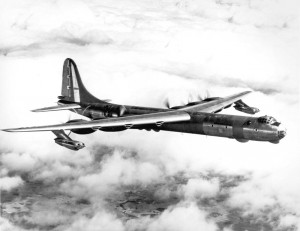
The B-36 Peacemaker carried a maximum bomb payload of two 42,000-pound Grand Slam bombs. It had six 3500-hp R4360 radial engines and four 5,200-pound J47-GE-19 turbojets.
While the Army surprisingly supported and facilitated the steps necessary to create a separate Air Force, the Navy continued its bitter opposition to the end. On Sept. 18, 1947, President Truman signed a bill granting the U.S. Air Force its independence as a full partner with the Army and the Navy. William Stuart Symington became the first secretary of the Air Force and Spaatz its first chief of staff. Within a month, on Oct. 14, 1947, Air Force test pilot Chuck Yeager flew the Bell XS-1 past the speed of sound. It was a boom heard around the world and launched the new Air Force into the supersonic era.
The Berlin blockade and the Cold War
The emerging threat posed by the Soviet Union and Communism convinced American leaders to rebuild its military forces, especially its air power.
Less than a year after becoming independent of the Army, the Air Force had its first test. On June 24, 1948, the world came close to the brink of war when the Soviet Union blockaded all land and water routes into the Allied sectors of Berlin. For 15 months, the U.S. Air Force and the Royal Air Force flew more than 53,325 tons of dry goods and 87,474 tons of liquid supplies into the beleaguered city of West Berlin. “Operation Plainfare” was called the greatest air transport operation of all time.
The role of the new Air Force in breaking the Soviet blockade demonstrated the value of air capabilities in this new “Cold War.”
The Soviet Union’s detonation of an atomic bomb in 1949 focused the need for long-range bombers, such as the B-36 Peacemaker, the B-47 Stratojet (the first pure jet strategic bomber) and other air defenses.
Korea—the baptism of fire
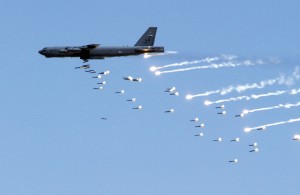
The B-52 replaced the B-36 and B-47 bombers. In January 2005, it marked 50 years of continuous service. Built as a Cold War deterrent, the Air Force has no plans to replace it.
The invasion of South Korea by communist North Korea, in June 1950, drew the Air Force into a bloody three-year conflict. The Air Force went to war with vintage WWII aircraft such as the B-26 Marauder bomber, C-47 Skytrain and F-51 Mustang fighter.
It wasn’t long, however, before they deployed a new jet fighter, the deadly F-86 Sabre, to establish air superiority over the Russian-built MiG 15. In a joint effort with Navy and Marine aviation, the Air Force helped protect United Nations ground forces with close air support and interdicted enemy reinforcements and supplies streaming down from North Korea.
Though often outgunned or outnumbered in the early days of the war, the Air Force maintained air superiority through training, the élan of its pilots and the support of its ground crews. A truce with the North Koreans ended the war in 1953. The Air Force had downed 975 enemy airplanes and created 39 aces.
After Korea, the Air Force kept a large number of units stationed in the Pacific to help contain communism. It also began a massive buildup of the forward-based United States Air Forces in Europe, from England to Turkey. Air Force units provided the cornerstone of the North Atlantic Treaty Organization, which provided a counter-balance against the Soviet-led Warsaw Pact for the next four decades.
Strategic Air Command

The Douglas C-47 Skytrain was a military transport developed from the Douglas DC-3 airliner. The Air Force used the aircraft for various roles, including AC-47 gunships—codenamed “Spooky” —in the Vietnam War.
In the late 1950s, the invention of the hydrogen bomb and long-range rockets accelerated the arms race between the Soviet Union and the U.S. Under the leadership of Gen. Curtis LeMay, the Air Force’s Strategic Air Command became the preeminent instrument of American defense strategy. SAC’s bombers, such as the B-47 and the long-range B-52 Stratofortress, remained on alert for the rest of the Cold War. The Titan and Minuteman intercontinental ballistic missiles joined the arsenal in the 1960s. Together with the Navy’s missile-launching atomic-powered submarines, these weapons were America’s nuclear “triad” deterrent. With the development of launch vehicles and orbital satellites, the Air Force mission also expanded into space.
Possession of strong strategic forces and weapons helped the United States prevail in the early 1960s, when the Soviet Union used Cuba as a proxy for communist expansion. Expansion in Southeast Asia, however, posed new and serious challenges.
Vietnam
Vietnam proved to be a challenging war for the Air Force. It began gradually for an unprepared U.S. With their use of air power constrained for political reasons, both Air Force and naval aviation had to support a protracted and unpopular counterinsurgency effort against a determined enemy.
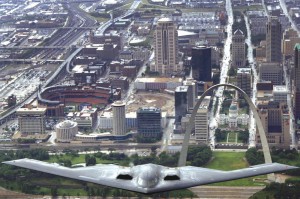
The B-2 Spirit bomber is a multi-role stealth heavy bomber capable of delivering both conventional and nuclear munitions. The B-2 introduced the satellite-guided Joint Direct Attack Munition in combat and was used in Afghanistan and Iraq.
Tactical aircraft, such as the versatile F-4 Phantom II, performed in a wide variety of roles, from aerial combat to close air support. The F-105 Thunderchief specialized in bombing raids against North Vietnam, while SAC B-52s “carpet bombed” remote jungle strongholds. Force multipliers, such as aerial refueling by KC-135 Stratotankers, enhanced all.
In 1964, the U.S. began full-scale military operations from the south. In 1965, the Air Force launched the first of three major air campaigns; “Operation Rolling Thunder” lasted from March 1965 to November 1968, against targets in the north. It was the longest bombing campaign ever conducted by the Air Force. Because of the strict rules of engagement, it failed in its objectives to end the Viet Cong counterinsurgency and stem the flow of men and arms to the south. The enemy perceived the limited bombings as a weakness, rather than negotiating points, as Washington politicians meant them.
In contrast, “Operation Linebacker” (March to October 1972), which was in response to the enemy’s Easter Offensive, brought U.S. air power fully to bear against North Vietnamese forces and facilities and was an overwhelming success.
In December 1972, President Nixon, in retaliation for North Vietnam’s diplomatic intransigence, ordered “Linebacker II” (Dec. 18-29). The operation was successful in compelling the enemy to sign a peace agreement in January 1973. However, by 1975, when most U.S. forces had left Vietnam, North Vietnam launched a successful invasion of the South.
1970s: new weapons systems
In the 1970s, the Air Force began modernizing its aircraft and missiles, while continuing to expand its role in space. During this period, the Air Force developed new weapon systems, including the A-10 Thunderbolt II, F-15 Eagle, F-16 Fighting Falcon and the E-3 Sentry.
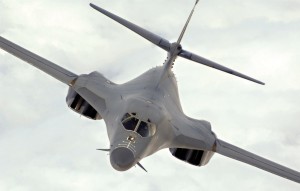
The B-1 Lancer bomber is a multi-role, long-range bomber, capable of flying intercontinental missions without refueling and penetrating present and predicted sophisticated enemy defenses.
The Air Force also made great strides in satellite-based communications, reconnaissance and navigation systems. With its large fleet of aerial refueling tankers and long-range transports, the Air Force also expanded its worldwide airlift capabilities. During the Arab-Israeli War of October 1973, C-141 Starlifters and giant C-5 Galaxies formed an aerial bridge to Israel in “Operation Nickel Grass.”
The military balance began to shift back in America’s favor after 1979. The Soviet Union’s invasion of Afghanistan and America’s humiliation during the hostage crisis in Iran confirmed the need to improve U.S. military preparedness. The defense buildup of the 1980s allowed the Air Force to expand its force structure, improve its training and readiness and deploy a wide range of advanced new weapons and electronic systems. These included the revolutionary F-117A Nighthawk stealth fighter and advanced radar systems.
During the 1980s, Air Force units engaged in several contingency operations, including “Urgent Fury” in Grenada in 1983; “El Dorado Canyon,” the raid on Libya in 1986; and “Just Cause,” the invasion of Panama in 1989. These operations demonstrated the capability of Air Force, Navy and Marine aviation to conduct successful joint operations.
U.S. progress with stealth airframes, sophisticated information networks and theoretical space-based systems convinced the Soviet leadership that its inefficient economic and political system could no longer compete in the Cold War. When the Berlin Wall came down in 1989, it marked the final days of the war and foreshadowed the dissolution of the Soviet Union.
Global reach
The Air Force’s flexibility, range and lethal ability gave America what Secretary of the Air Force Donald B. Rice called “global reach, global power.”
Air Force personnel and sophisticated weapons lived up to this vision during “Operation Desert Storm,” in early 1991. Deploying halfway around the world in “Operation Desert Shield,” after Iraqi dictator Saddam Hussein invaded Kuwait in August 1990, they helped win one of the most lopsided battlefield victories in military history. Advanced stealth aircraft such as the F-117 Nighthawk, B-1B Lancer and B-2 Spirit bombers delivered an arsenal of precision-guided munitions, with the help of sophisticated information and satellite-based navigation systems and the E-3 Sentry aircraft.
Under the command of Lt. Gen. Charles A. Horner, the intensive six-week air campaign neutralized Iraq’s air defenses, decapitated Iraq’s command structure and demoralized its once-feared army. Air power allowed coalition ground forces to liberate Kuwait in a matter of weeks.
Downsizing the Air Force

The F-22 Raptor is a fifth-generation stealth fighter. It carries air-to-air missiles in internal bays to avoid disrupting its stealth capability. Its speed is estimated to exceed Mach 2.
The end of the Cold War didn’t mean the Air Force’s missions were over, but the U.S. no longer needed the large force structure that stood guard during that time. Without the Soviet threat, politicians decided to streamline the Air Force in the early 1990s, and it underwent the most complete reorganization since its establishment almost 50 years earlier. It consolidated from 13 to eight major commands, replacing the Strategic Air, Tactical Air and Military Airlift Commands with Air Combat and Air Mobility Commands. The Air Force also deactivated many squadrons, closed dozens of air bases and downsized from more than 600,000 military personnel in the late 1980s to under 388,000 by 1996.
Humanitarian operations
Although smaller, the Air Force was called upon for increased participation in contingency operations. In addition to maintaining units in the Persian Gulf and Turkey, to deter Saddam Hussein from threatening his neighbors, the Air Force supported humanitarian and peacekeeping operations such as “Restore Hope” in Somalia, “Support Hope” in Rwanda, “Uphold Democracy” in Haiti and “Provide Promise” and “Deny Flight” in the Balkans. To help stop a civil war in Bosnia, Air Force aircraft made precision strikes against Serbian targets in “Operation Deliberate Force” during late 1995. After this first air campaign ever conducted by NATO, the Air Force then supported implementation of the Dayton Peace Accords through “Operations Decisive” and “Joint Endeavor.”
21st century Air Force
In response to the terrorists’ attacks of Sept. 11, 2001, special operations units and Air Force bombers struck Taliban and Al Qaeda targets in Afghanistan. Air Force units, now part of the NATO force in Afghanistan, provide support missions for the continued war against terror.
In March 2003, the U.S. led a coalition of nations to overthrow Iraq’s Hussein. In the opening weeks of the war, the Air Force flew more than 30,000 sorties, including 12,000 strike sorties, and dropped more than 21,300 munitions, 70 percent precision-guided. The Air Force destroyed the combat effectiveness of the Iraqi ground forces, blinded the Hussein leadership and paved the way for a series of ground battles that saw Baghdad fall in 22 days.
The future: network-centric warfare
Today’s asymmetrical battlegrounds require the Air Force to combine stealth and speed into a new generation of piloted aircraft, such as the F-22 Raptor and the F-35 Joint Strike Fighter Lightning II, and unpiloted aircraft that commingle data, situational and information sharing and munitions. The virtually unlimited potential of supersonic scramjet technology will push aircraft to speeds of Mach 4 to Mach 7, and hypersonic flight beyond Mach 10, already achieved in 2005, will insure that victory belongs to whoever rules the sky: the U. S. Air Force.











